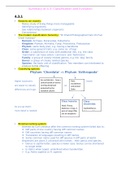Summary of 4.3: Classification and Evolution
4.3.1
Reasons we classify:
- Makes study of living things more manageable
- Identifying organisms
- See relationships between organisms
- Convenience
The modern classification hierarchy: “Dr Khalid Photographed Cats On Five
Great Sundays”
- Domain: Archaea, Eukaryotae, Eubacteria
- Kingdom: Plantae, Animalia, Fungi, Protoctista, Prokaryotae
- Phylum: same body plan, e.g. having a backbone
- Class: same general traits, e.g. same no. of legs
- Order: a subdivision of class with additional info, e.g. the class
‘mammalia’ can have orders ‘carnivora’ and ‘herbirvora’
- Family: a group of closely related genera, e.g. the ‘dog’ family
- Genus: a group of closely related species
- Species: the basic unit of classification. Two members can interbreed to
produce fertile offspring.
Classifying species:
Phylum ‘Chordata’ vs Phylum ‘Arthropoda’
Are vertebrates – have a
Higher taxonomic Have levels
central bundle of nerves
exoskeleton
are easier to classify running along back as and jointed
protected by the
differences are huge: limbs
vertebral column
Class Insecta: Class
Arachnida:
Head, Thorax,
As you go lower,
Abdomen, 6 legs, 2 Cephalothorax,
more detail is needed: pairs of wings (flies Abdomen, 8 legs
are an exception)
Binomial naming system:
- Devised by Carl Linnaeus after the common naming system failed due to:
Diff parts of one country having diff common names
Diff countries having diff common names
Translation of languages resulting in diff names
Same common name used for diff species in diff parts of world
- Organisms are given 2 universal latin names – their genus and species.
Genus is capital letter, species is lower case. Genus can be shortened
to single letter.
In italics when typed, underlined when handwritten.
E.g: Homo sapiens or H. sapiens
, Summary of 4.3: Classification and Evolution
4.3.2
Using observable features:
- The biological definition of a species can’t be applied to organisms that
reproduce asexually, or those that are only known through fossils.
- The phylogenetic definition of a species is ‘a group of individual
organisms that are very similar in appearance, anatomy,
physiology, biochemistry and genetics’.
- In early attempts at classification, Aristotle classified all living things as
either plant or animal. The animals were further divided into 3 categories:
(based on observable features like having fins, legs or wings)
Live and move in air
Live and move in water
Move through the air
Using more detailed evidence:
- By the 17th century when microscopes were developed, it was clear that all
organisms couldn’t fit into either the animal or the plant kingdom. For
instance, the electron microscope revealed that some unicellular
organisms had both animal AND plant features.
Euglena is a unicellular organism that has chloroplasts to
photosynthesise, but can also move around with a flagellum.
Fungi also doesn’t fit into either plant or animal kingdoms. Like plants,
they can’t move and their hyphae grow like roots, however they also
don’t photosynthesise and digest organic matter like animals.
- As a result, we now have 5 kingdoms. They are still based on observable
features, but at a microscopic level.
Animalia: eukaryotic, multicellular, heterotrophic (large organic
molecules – smaller molecules for absorption), can usually move
Plantae: eukaryotic, multicellular, autotrophic, cellulose cell wall,
chlorophyll
Fungi: eukaryotic, unicellular/have a mycelium, chitin cell walls,
multinucleate cytoplasm, mostly free-living and saprophytic (cause
decay of organic matter)
Protoctista: eukaryotic, mostly unicellular but some algae are
multicellular, variety of plant and animal like features, mostly free
living, autotrophic/heterotrophic nutrition (some photosynthesise,
some ingest prey, some are parasites, some feed using extracellular
enzymes).
Prokaryotae: have cells smaller than those in eukaryotes, no nucleus,
loop of naked DNA which isn’t in linear chromosomes, no membrane-
bound organelles, relatively small ribosomes, may be free-living or
parasitic.
4.3.3
Although using observable features to classify has been successful, 2 unrelated
species could look similar due to adaptations (convergent evolution).




